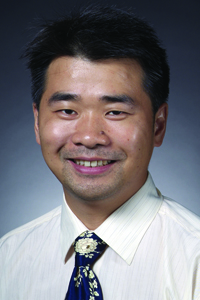by Thane Himes
Liang Dong recently completed research on a device that can help scientists find more effective ways to protect crops and combat Parkinson’s disease by studying, of all things, worms.

Nematodes possess simple nervous systems, but still share important characteristics with the nervous systems of humans. By studying nematode nerves, researchers can learn more about the human nervous system and how diseases such as Parkinson ’s disease affect it. In addition, learning more about the nematode nervous system allows researchers to devise more advanced pesticides to fight pathogens.
Over the last eighteen months, Dong, assistant professor in the Iowa State University Department of Electrical and Computer Engineering , has worked with Richard J. Martin, professor of biomedical sciences in the College of Veterinary Medicine, and ECpE graduate students Peng Liu and Depeng Mao, to develop a device that can detect the muscular force of nematodes. The finished device, a “lab on a chip”, can detect such force with greater accuracy, efficiency, and cost-effectiveness than existing methods. Dong’s research was supported by the National Science Foundation and the McGee-Wagner Research Fund.
“The device is small, cost-effective, accurate, and disposable,” Dong said. “I can see a lot of people who will be interested in that.”
The device measures only about .25 square inches and features many tiny, micro fabricated channels. It uses two optical fibers; one single-mode fiber and one multimode fiber. The single mode fiber allows researchers to send a light into the fiber. The multimode fiber then detects the intensity of that light when a worm navigates through the channels. The device itself measures the change in the single-mode fiber’s light intensity; the greater the light intensity, the greater the actual muscle force generated. The device uses multiple detection points, which ensure far greater accuracy by averaging the recorded data from each point.
With such a complex function to explore, why use nematodes for these kinds of experiments? For one, they’re inexpensive, and can be purchased hundreds at a time for a few dollars. Their one-millimeter size also makes them easy to handle in a laboratory, not to mention the tiny lab on a chip.
According to Dong, 35-percent of the genes in a Caenorhabditis elegans (or C. elegans) nematode are similar to the genes of human beings. Nematode samples are simple, easy to study, and still retain enough similarity to humans to have practical applications. The researchers used a different type of nematode than the C. elegans in the experiment, but the technology the group developed can be adapted to measure the C. elegans without modification.
The research, which was featured in Vertical NEWS and published in Lab on a Chip as “An integrated fiber-optic microfluidic device for detection of muscular force generation of microscopic nematodes”, has an impact that goes far beyond nematodes. Dong’s research on nematode systems can be adapted for use on human nervous systems, and can help provide valuable data on conditions like Parkinson’s disease.
“A sensor for nematodes will help biologists studying the nervous system towards finding a way to help patients with Parkinson’s,” Dong said.
Further, measuring muscular force can show how resistant the worms are to specific chemical combinations. Researchers can use data collected from Dong’s lab on a chip to devise chemical combinations for which nematodes and other pathogens have no resistance. This could lead to breakthroughs in the science of crop protection and provide farmers with more advanced pesticides that kill pests but preserve the environment.
“There are many kinds of parasites and pathogens out there, and most of them have developed some level of resistance,” Dong said. “A critical issue is how to kill parasites and pathogens while protecting the environment. You want to accurately measure their drug resistance to find the proper methods to deal with them.”
The next step in Dong’s research is to find opportunities in the biomechanics industry to develop an official prototype device that can then be commercialized. Dong is confident that companies and organizations will see the benefits of his design.
